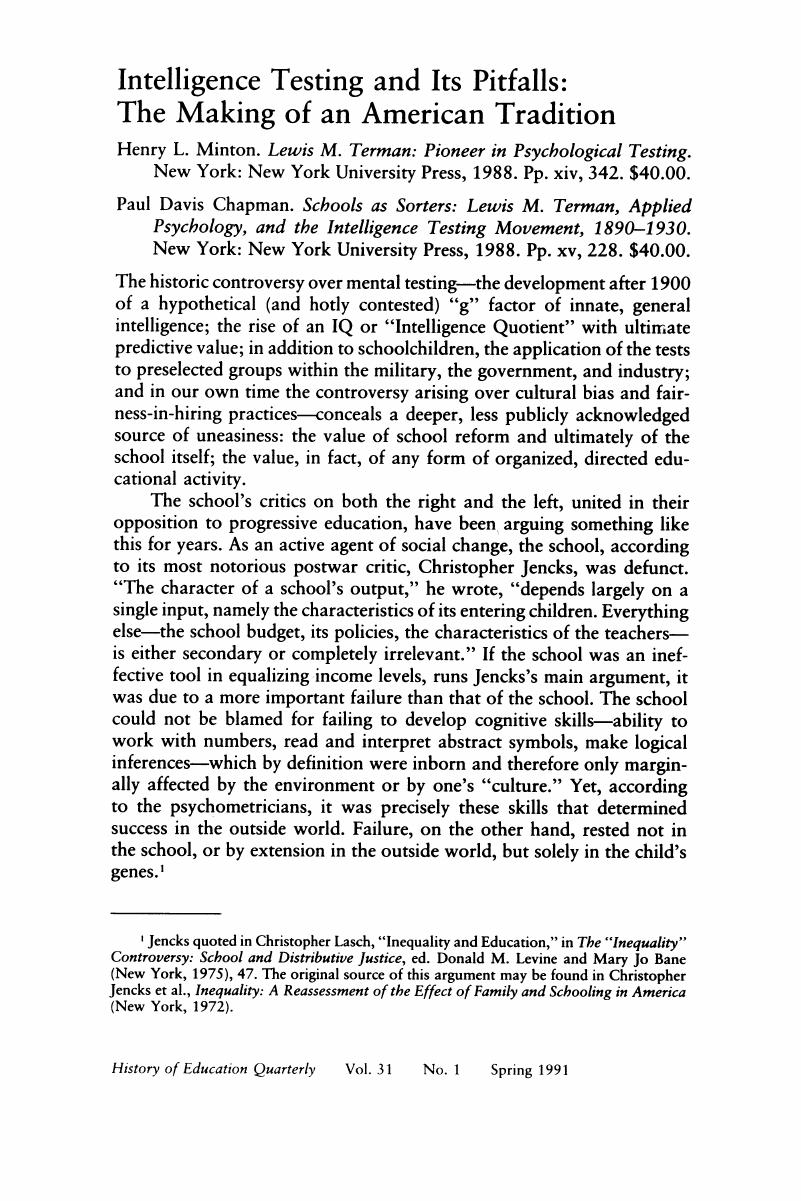No CrossRef data available.
Article contents
Intelligence Testing and Its Pitfalls: The Making of an American Tradition - Henry L. Minton. Lewis M. Terman: Pioneer in Psychological Testing. New York: New York University Press, 1988. Pp. xiv, 342. $40.00. - Paul Davis Chapman. Schools as Sorters: Lewis M. Terman, Applied Psychology, and the Intelligence Testing Movement, 1890–1930. New York: New York University Press, 1988. Pp. xv, 228. $40.00.
Published online by Cambridge University Press: 24 February 2017
Abstract

- Type
- Essay Reviews
- Information
- Copyright
- Copyright © 1991 by the History of Education Society
References
1. Jencks quoted in Lasch, Christopher, “Inequality and Education,” in The “Inequality” Controversy: School and Distributive Justice, ed. Levine, Donald M. and Bane, Mary Jo (New York, 1975), 47. The original source of this argument may be found in Jencks, Christopher et al., Inequality: A Reassessment of the Effect of Family and Schooling in America (New York, 1972).Google Scholar
2. Rosenberg, Charles E., No Other Gods: On Science and American Social Thought (Baltimore, 1976), 6.Google Scholar
3. Resnick, Daniel, “History of Educational Testing,” in Ability Testing: Uses, Consequences, and Controversies, Part II, ed. Wigdor, Alexandra K. and Garner, Wendell R. (Washington, D.C., 1982), 191.Google Scholar
4. Ibid., 191–92.Google Scholar
5. Parsons, Frank, Our Country's Needs: Or the Development of a Scientific Industrialism (Boston, 1894), 69; Link, H. C., Employment Psychology: The Application of Scientific Methods to the Selection, Training, and Grading of Employees (New York, 1919), 293; Matthew Hale examines these trends in “History of Employment Testing,” in Ability Testing, ed. Wigdor, and Garner, , 3–38; see especially his excellent bibliography.Google Scholar
6. Thorndike, Edward L., “Educational Diagnosis,” Science, n.s., 37 (1913): 139.Google Scholar
7. The decline of testing is documented in Hale, “History of Employment Testing,” 18–20; Borow, H. C., “The Growth and Present Status of Occupational Testing,” Journal of Consulting Psychology 8 (1944): 70–73; and Baritz, Loren, Servants of Power: A History of the Use of Social Science in American Industry (Middletown, Conn., 1960). The pre-testing of workers prior to employment would not, Mayo concluded, elicit any useful information or serve as a predictor of success: “The belief that the behavior of an individual within the factory can be predicted before employment upon the basis of a laborious and minute examination by tests of his technical and other capacities is mainly, if not wholly, mistaken” (Mayo, Elton, The Social Problems of Industrial Civilization [Boston, 1945], 111).CrossRefGoogle Scholar
8. Larson, A., Employment Discrimination: Race (New York, 1977), 1: 13–15.Google Scholar
9. The phrase to “test tests” was used by the industrial psychologist Henry Link, quoted in Hale, “History of Employment Testing,” 17; the phrase “trainability” by Bigham, Walter V., chief psychologist of the Army in 1940, also quoted in Hale, 23.Google Scholar
10. Novick, Melvin, “Ability Testing: Federal Guidelines and Professional Standards,” in Ability Testing, ed. Wigdor, and Garner, , 93; some of this literature is reviewed in “Special Issue: On Bias in Selection,” Journal of Educational Measurement 13 (no. 1, 1976).Google Scholar
11. Croly, Herbert, The Promise of American Life (New York, 1910), ch. 13.Google Scholar
12. Jensen, Arthur R., “Differential Psychology: Towards Consensus,” in Arthur Jensen: Consensus and Controversy, ed. Sohan, and Modgil, Celia (New York, 1987), 396.Google Scholar




